牛津译林版(2019)必修第二册Unit 4 Welcome to the unit & Reading 课件(共43张PPT)
文档属性
| 名称 | 牛津译林版(2019)必修第二册Unit 4 Welcome to the unit & Reading 课件(共43张PPT) | 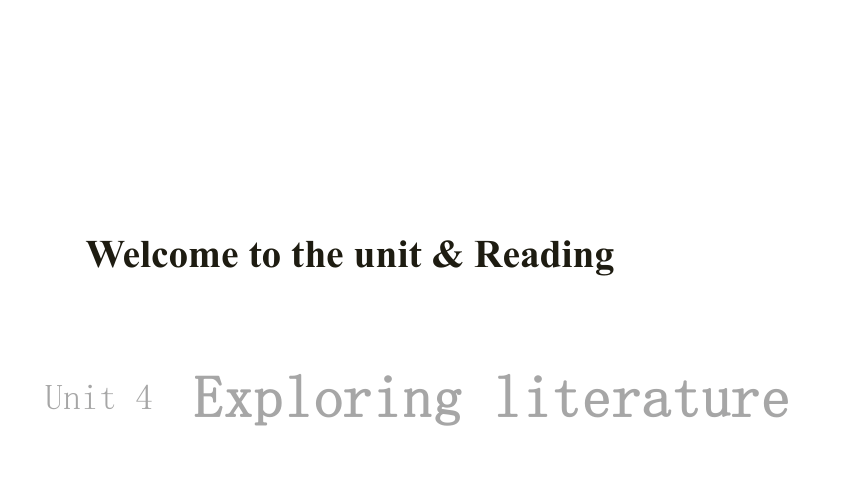 | |
| 格式 | pptx | ||
| 文件大小 | 24.2MB | ||
| 资源类型 | 教案 | ||
| 版本资源 | 牛津译林版(2019) | ||
| 科目 | 英语 | ||
| 更新时间 | 2024-03-27 22:18:08 | ||
图片预览

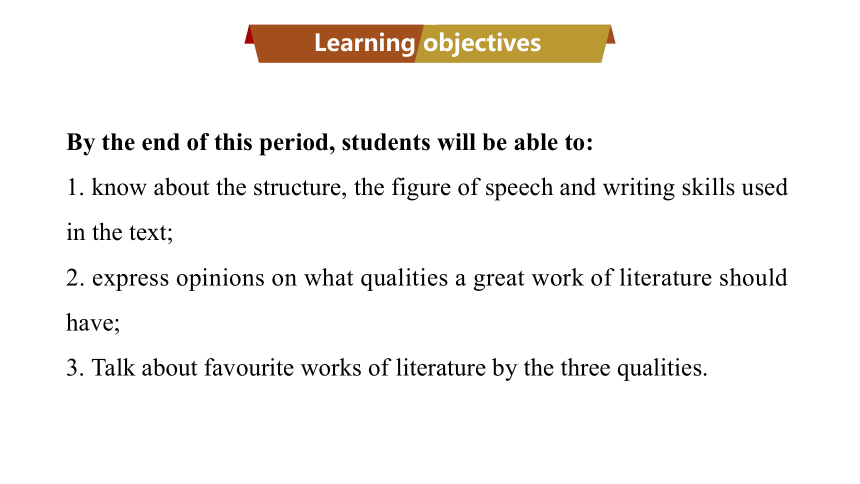
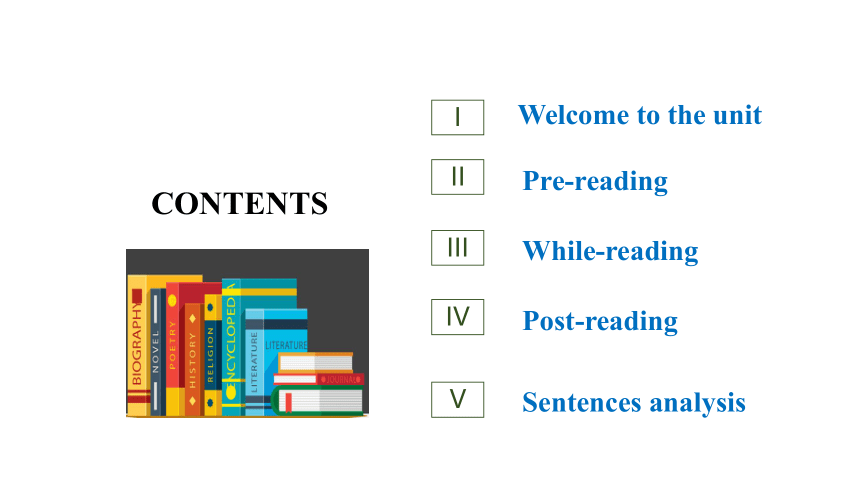
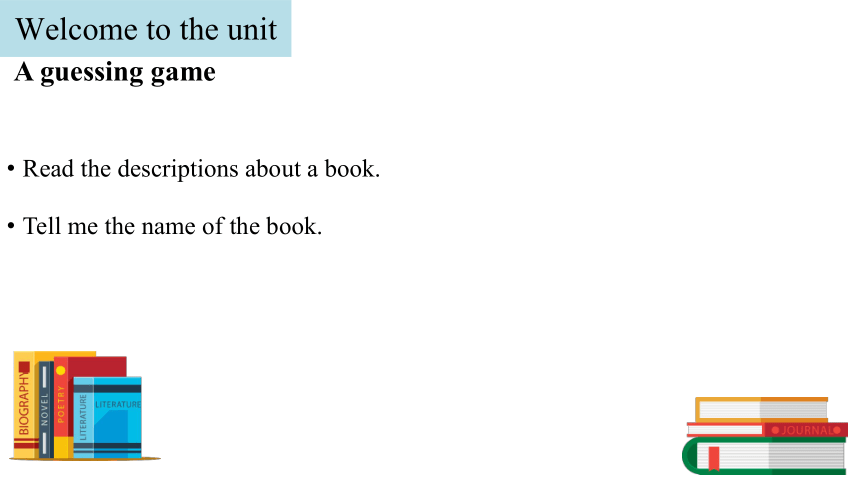
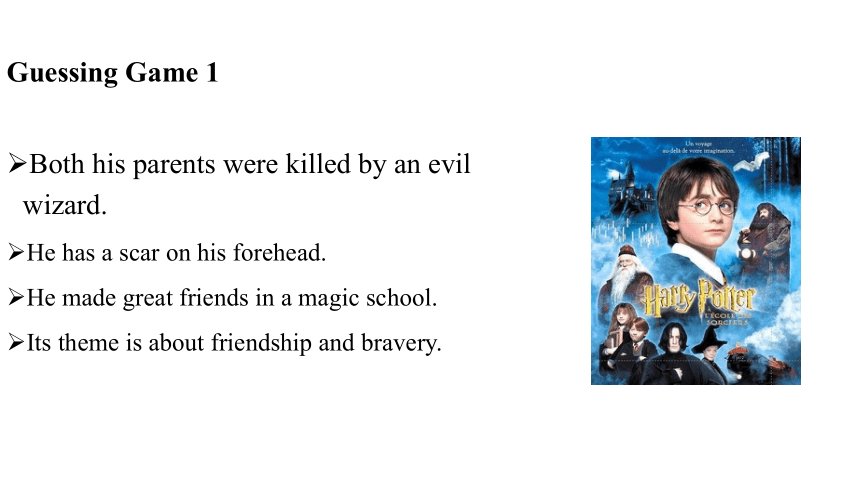
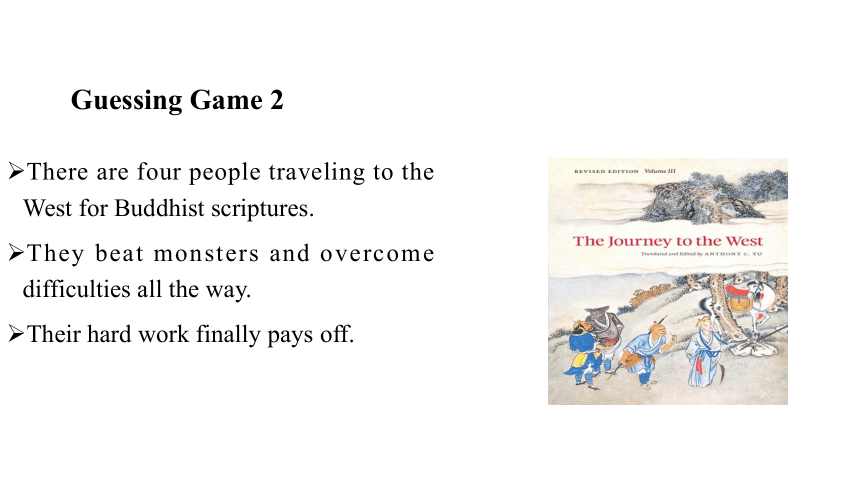
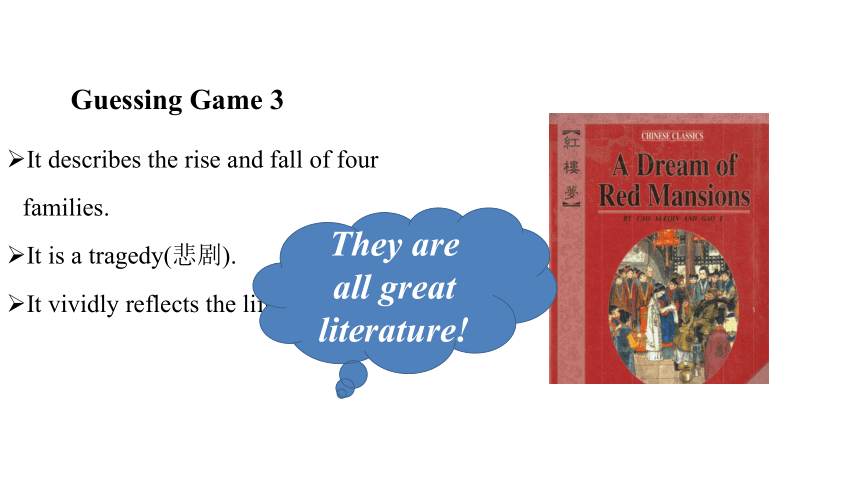
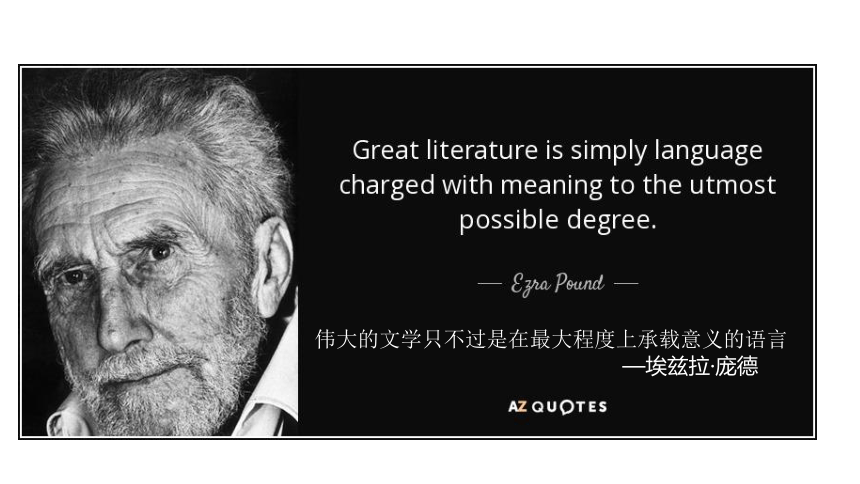
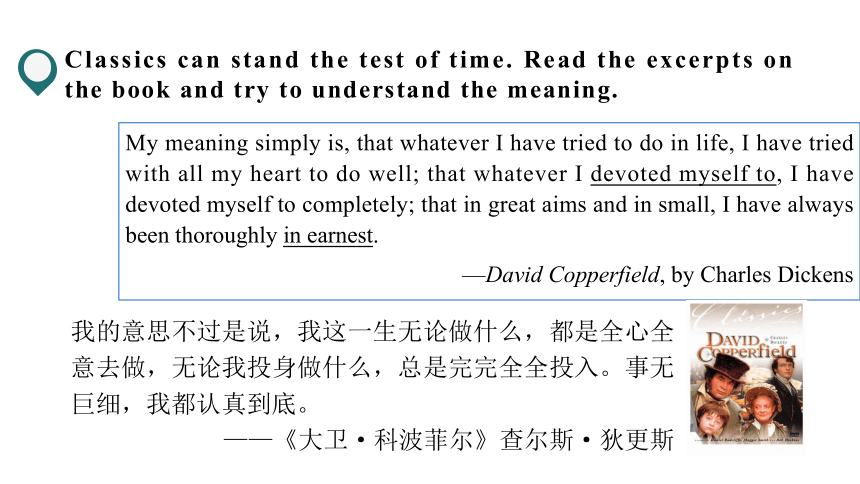

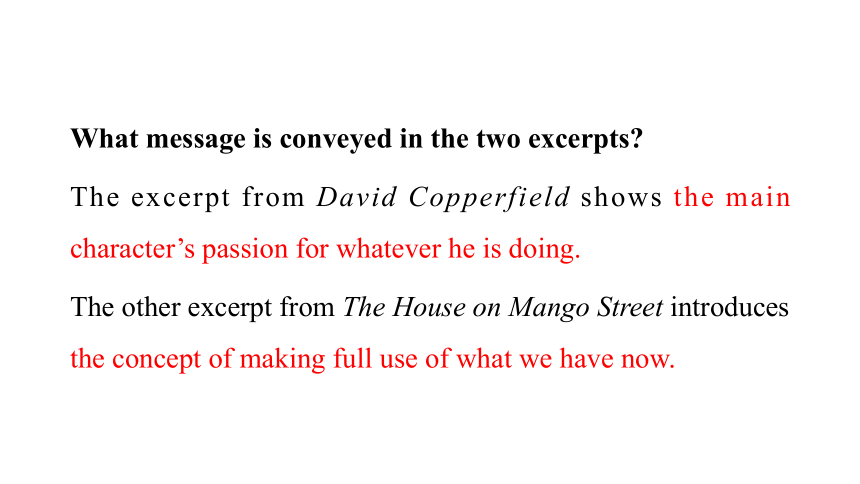
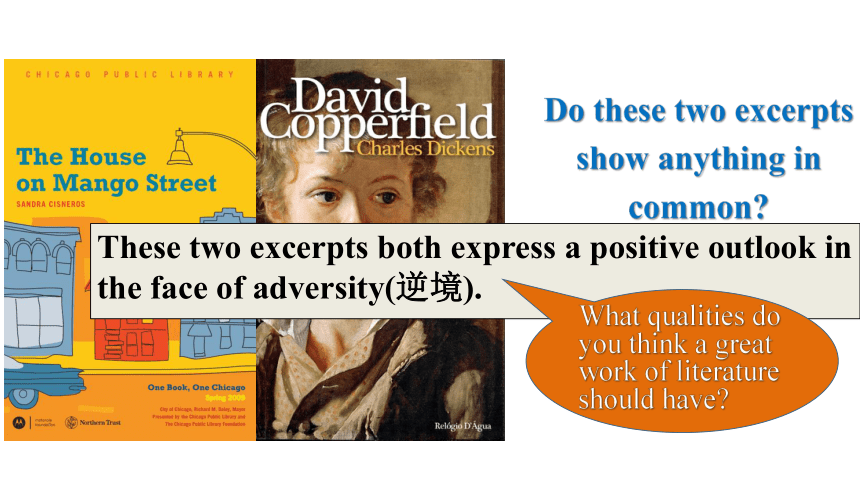
文档简介
(共43张PPT)
Welcome to the unit & Reading
Unit 4
Exploring literature
By the end of this period, students will be able to:
1. know about the structure, the figure of speech and writing skills used
in the text;
2. express opinions on what qualities a great work of literature should
have;
3. Talk about favourite works of literature by the three qualities.
Learning objectives
CONTENTS
Pre-reading
I
While-reading
II
Post-reading
III
Sentences analysis
IV
V
Welcome to the unit
A guessing game
Read the descriptions about a book.
Tell me the name of the book.
Welcome to the unit
Guessing Game 1
Both his parents were killed by an evil wizard.
He has a scar on his forehead.
He made great friends in a magic school.
Its theme is about friendship and bravery.
There are four people traveling to the West for Buddhist scriptures.
They beat monsters and overcome difficulties all the way.
Their hard work finally pays off.
Guessing Game 2
It describes the rise and fall of four families.
It is a tragedy(悲剧).
It vividly reflects the life in Qing dynasty.
They are all great literature!
Guessing Game 3
伟大的文学只不过是在最大程度上承载意义的语言
—埃兹拉·庞德
My meaning simply is, that whatever I have tried to do in life, I have tried with all my heart to do well; that whatever I devoted myself to, I have devoted myself to completely; that in great aims and in small, I have always been thoroughly in earnest.
—David Copperfield, by Charles Dickens
Classics can stand the test of time. Read the excerpts on the book and try to understand the meaning.
我的意思不过是说,我这一生无论做什么,都是全心全意去做,无论我投身做什么,总是完完全全投入。事无巨细,我都认真到底。
——《大卫·科波菲尔》查尔斯·狄更斯
You can never have too much sky. You can fall asleep and wake up drunk on sky, and sky can keep you safe when you are sad. Here there is too much sadness and not enough sky. Butterflies too are few and so are flowers and most things that are beautiful. Still, we take what we can get and make the best of it.
—The House on Mango Street, by Sandra Cisneros
你永远不能拥有太多的天空。你可以在天空下睡去,醒来又沉醉。在你忧伤的时候,天空会给你安慰。可是忧伤太多,天空不够,蝴蝶不够,花儿也不够。大多美好的东西都不够。于是,我们取我们所能取,好好的享用。
——桑德拉·希斯内罗斯《芒果街上的小屋》
What message is conveyed in the two excerpts
The excerpt from David Copperfield shows the main character’s passion for whatever he is doing.
The other excerpt from The House on Mango Street introduces the concept of making full use of what we have now.
Do these two excerpts show anything in common
These two excerpts both express a positive outlook in the face of adversity(逆境).
What qualities do you think a great work of literature should have
easy to understand
…
attractive and enjoyable
innovative/creative
well-organized
stand the test of time
Qualities
Qualities a great work of literature should have
Do you want to learn more about literature
Pre-reading
While-reading
Activity 1 Fast-reading for main ideas
1. What is the text mainly about
A. What literature is.
B. Three qualities of literature.
C. Why we should like literature.
D. The story of a child and a man.
√
Introduction
Conclusion
Its description of truth and beauty
Its appeal to our feelings and imagination
Permanence
introduce the topic
three qualities
the significance
argumentation
Read the article and find the main idea of each part.
Read for the structure
Para. 1
Para.2
Para.3
Para.4
Para.5
Para.6
Para. 1
Para.2
Para.3
Para.4
Para.5
Para.6
√
Paras. 1-2
1. How does the writer introduce the topic of the text
A. By giving a definition.
B. By giving an example.
C. By listing numbers.
D.By comparing.
The sounds are too faint for human ears.
√
Activity 2 Careful-reading for details
2. What does “them” in Line 3 refer to
3. What does the word “it” in Line 10 refer to
4. What do we need to do in order to enter and enjoy the new world mentioned in the second paragraph
“Them” in Line 3 refers to strange, low, musical sounds.
“it” in Line 10 refers to literature.
We need to love literature, and make an effort to explain it.
5.What does the man stand for
____________________________________________________________________________________________________________
6.What does the child stand for
______________________________________________________
The man stands for people who make an effort to explain and understand literature.
The child stands for people who love and enjoy literature.
Paras. 3-5
1. Read for the structure
The first quality of literature is its description of truth and beauty. Some truth and beauty remain unnoticed until a sensitive human soul brings them to our attention, just as the shell reflects the unnoticed sounds. A hundred men may pass a field and see only dead grass; but a poet stops, looks deeper, sees truth and beauty, and writes, “Yesterday’s flowers am I.” One who reads it is capable of seeing the beauty that was hidden from his eyes before.
Point
Explanation
Example
2. Why does the author give the example of a poet
A. To ask us to care the truth and beauty of literature.
B. To ask us to read more poems written by the poet.
C. To stop to look at the dead grass and write poems.
D. To stop to talk with a sensitive human soul.
√
3. Have a discussion
How do you understand the line of the poet “Yesterday’s
flowers am I”
Yellow dead grass
Beautiful flowers
A poet
A hundred men
VS
A sensitive human soul brings the unnoticed beauty to our attention.
The literal meaning of this line is that the dead grass may once have been blooming flowers.
The poet wants to remind readers of the former glory of a thing.
A good poet often notices something unnoticed by others and can present it to readers with vivid language.
How do you understand the line of the poet “Yesterday’s
flowers am I”
4. What does “what it awakens in us” refer to in Paragraph 4
It refers to the feelings and imagination that can be stirred by literature in our mind.
5. Why does the author give the example of Faustus in Para. 4
A. To appeal to us to read the stories about him.
B. To seek the answer to his question.
C. To prove that Helen is a beauty and heroine.
D. To tell that literature can inspire readers’ imagination.
√
“Was this the face that launched a thousand ships ” he opens a door through which our imagination enters a new world, a world of love, beauty and heroism.
Helen: Helen of Troy, 特洛伊的海伦是希腊神话中的绝世美女,原是希腊南部斯巴达国国王 Menelaus的妻子,特洛伊的王子Paris贪恋她的美貌,在爱与美之神Aphrodite的帮助下,把Helen诱拐了。国王当时出远门了,回来得知后大怒,发誓要血洗特洛伊。就这样两国展开了十年之久的战争,双方死伤无数,最后希腊采用了“木马计”—the Trojan Horse ,战胜了Troy,杀死了Paris,抢回了Helen。
In summary, literature is the expression of life in forms of truth and beauty, the written record of man’s thoughts and feelings, and the history of the human soul.
总之,文学是以真和美的形式对生命的表达,是人类思想和感情的写照,是人类灵魂的历史。
Translate the last paragraph into Chinese.
Para. 6
What writing techniques does the author not use in Paras. 3-4
A.Comparison(作比较).
B.Quotation(引用).
C.Giving examples.
D.Listing numbers.
√
Writing techniques
Further-reading
1. Let a little song appeal to the ear, or a great book to the heart, and we discover a new world, a world of dreams and magic. (Para. 2, lines 8–9)
Parallelism, also called parallel structure, is the similarity of structure in a pair or series of related words, phrases, or clauses.
Parallelism has the potential to create rhythm, emphasis, and drama as it clearly presents ideas or action.
Rhetorical Device (修辞手法)
Parallelism(排比)
Anadiplosis(顶真)
Anadiplosis is commonly used for emphasis through the repetition of a key word or phrase, or to link a common theme through several separate clauses—often more than two. It’s also useful as a rhythmic device, breaking up what would otherwise be straightforward clauses and giving them an extra pause. This often results in a sentence that is more interesting to read or hear.
2. Behind every book is a man, behind the man is the race, and behind the race are the natural and social environments. (Para. 2, lines 10–12)
Analogy(类比)
3. Some truth and beauty remain unnoticed until a sensitive human soul brings them to our attention, just as the shell reflects the unnoticed sounds. (Para. 3, lines 15–17)
Analogy is a figure of speech in which two fundamentally unlike things are explicitly compared, usually in a phrase introduced by like or as.
In everyday conversations as well as in writing and formal speeches, we use analogies to clarify ideas, create memorable images, and emphasize key points.
1. How is the story of the child and the man related to the topic of literature?(Critical Thinking 批判性思维)
The story of the man and the child is similar to the study of literature. The child stands for people who love and enjoy literature, while the man stands for people who make an effort to explain and understand literature. The child is amazed at the sounds he hears through a shell, just as a literature-lover discovers a new world through the study of literature. The shell catches a range of sounds that human ears would have missed, just as great writers bring unnoticed truth and beauty in the world to the reader’s attention.
Post-reading
Activity 1 Discussion
2. Judge your favourite Chinese work of literature by the three qualities in the article. How does it measure up (Creative Thinking创造性思维)
__________________________________________________________
Answers may vary.
A child 1._______(find) a shell and amazed at the sound from it may not realize that he has discovered 2.____unnoticed new beautiful world. Literature has appealed 3.______ so many people with its three significant 4._________(quality).Firstly, literature presents truth and beauty. Those who read the works of literature will be able to see the 5.______ (hide) beauty too. Secondly, literature can appeal to us to dig out our own feelings. 6._____ attracts us most is that literature can use its words 7._______(lead) us to have the power to feel and imagine, 8.______ guides readers into a world of love,beauty and heroism. Thirdly, with the two features above combined, literature will try to be 9.___________(permanence).In summary, literature is the 10.___________(express) of life in forms of truth and beauty, the written record of man’s thoughts and feelings, and the history of the human soul.
finding
an
to
qualities
hidden
What
to lead
Activity 2 Summary
which
permanent
expression
1. Then the man explained that the child heard nothing strange, and
that the shell caught a range of sounds too faint for human ears. (Para. 1 Line 4)
[句式分析] 本句是一个______句。主句中动词explain后跟两个由that引导的并列_______从句,通常第一个that________省略,第二个that_________省略。
[自主翻译]
复合
宾语
不可
可以
Sentences analysis
随后男子解释说,孩子听到的声音并没有什么奇怪的,
只不过是贝壳捕捉到了各种对人的耳朵来说太微弱的声音而已。
2.Behind every book is a man, behind the man is the race, and behind the race are the natural and social environments.(Para. 2 Line 10)
[句式分析] 本句是and连接的________句。三个分句都是表语前置的_____________句。表示处所或方位的介词短语behind…置于句首时,要把_________整体移到主语之前。
[自主翻译]
并列
完全倒装
谓语
每本书背后都有一个人,此人身后是一个民族,这个
民族的背后是自然和社会环境。
3.Some truth and beauty remain unnoticed until a sensitive human soul brings them to our attention, just as the shell reflects the unnoticed sounds.(Para. 3 Line 15)
[句式分析] 此句是_________句,until引导___________从句,as引导___________从句。
[自主翻译]
复合
时间状语
方式状语
有些真与美一直不为人所察觉,直到一个敏锐的人类
灵魂让它们引起我们的注意,正如贝壳把那些被人忽视的声音呈现出来一样。
4. One who reads it is capable of seeing the beauty that was hidden from his eyes before.(Para. 3 Line 19)
[句式分析] 此句是_______句,who引导_______从句,修饰one,在从句中作_______,that引导_______从句,修饰the beauty,在从句中作_________。
[自主翻译]
复合
定语
主语
定语
主语
读到这句诗的人可以发现曾视而不见的美。
5. When Christopher Marlowe’s Doctor Faustus asks in the presence of Helen,“Was this the face that launched a thousand ships?” he opens a door through which our imagination enters a new world, a world of love, beauty and heroism. (Para. 4 Line 22)
[句式分析] 此句是________句,when引导___________从句;在直接引语中that引导________从句,修饰the face,在从句中作________;through which是“_______________”引导的________从句,修饰a door;a world of love, beauty and heroism是___________。
[自主翻译]
复合
时间状语
定语
主语
介词+关系代词
定语
同位语
当克里斯托弗·马洛笔下的浮士德博士当着海伦的面
问道,“这就是让一千艘战船起航的那张面孔吗?”他便打开了一扇门,通过这扇门,我们的想象力进入了一个充满爱、美和英雄主义的新世界。
Homework
Review what we have learnt and preview language points.
Welcome to the unit & Reading
Unit 4
Exploring literature
By the end of this period, students will be able to:
1. know about the structure, the figure of speech and writing skills used
in the text;
2. express opinions on what qualities a great work of literature should
have;
3. Talk about favourite works of literature by the three qualities.
Learning objectives
CONTENTS
Pre-reading
I
While-reading
II
Post-reading
III
Sentences analysis
IV
V
Welcome to the unit
A guessing game
Read the descriptions about a book.
Tell me the name of the book.
Welcome to the unit
Guessing Game 1
Both his parents were killed by an evil wizard.
He has a scar on his forehead.
He made great friends in a magic school.
Its theme is about friendship and bravery.
There are four people traveling to the West for Buddhist scriptures.
They beat monsters and overcome difficulties all the way.
Their hard work finally pays off.
Guessing Game 2
It describes the rise and fall of four families.
It is a tragedy(悲剧).
It vividly reflects the life in Qing dynasty.
They are all great literature!
Guessing Game 3
伟大的文学只不过是在最大程度上承载意义的语言
—埃兹拉·庞德
My meaning simply is, that whatever I have tried to do in life, I have tried with all my heart to do well; that whatever I devoted myself to, I have devoted myself to completely; that in great aims and in small, I have always been thoroughly in earnest.
—David Copperfield, by Charles Dickens
Classics can stand the test of time. Read the excerpts on the book and try to understand the meaning.
我的意思不过是说,我这一生无论做什么,都是全心全意去做,无论我投身做什么,总是完完全全投入。事无巨细,我都认真到底。
——《大卫·科波菲尔》查尔斯·狄更斯
You can never have too much sky. You can fall asleep and wake up drunk on sky, and sky can keep you safe when you are sad. Here there is too much sadness and not enough sky. Butterflies too are few and so are flowers and most things that are beautiful. Still, we take what we can get and make the best of it.
—The House on Mango Street, by Sandra Cisneros
你永远不能拥有太多的天空。你可以在天空下睡去,醒来又沉醉。在你忧伤的时候,天空会给你安慰。可是忧伤太多,天空不够,蝴蝶不够,花儿也不够。大多美好的东西都不够。于是,我们取我们所能取,好好的享用。
——桑德拉·希斯内罗斯《芒果街上的小屋》
What message is conveyed in the two excerpts
The excerpt from David Copperfield shows the main character’s passion for whatever he is doing.
The other excerpt from The House on Mango Street introduces the concept of making full use of what we have now.
Do these two excerpts show anything in common
These two excerpts both express a positive outlook in the face of adversity(逆境).
What qualities do you think a great work of literature should have
easy to understand
…
attractive and enjoyable
innovative/creative
well-organized
stand the test of time
Qualities
Qualities a great work of literature should have
Do you want to learn more about literature
Pre-reading
While-reading
Activity 1 Fast-reading for main ideas
1. What is the text mainly about
A. What literature is.
B. Three qualities of literature.
C. Why we should like literature.
D. The story of a child and a man.
√
Introduction
Conclusion
Its description of truth and beauty
Its appeal to our feelings and imagination
Permanence
introduce the topic
three qualities
the significance
argumentation
Read the article and find the main idea of each part.
Read for the structure
Para. 1
Para.2
Para.3
Para.4
Para.5
Para.6
Para. 1
Para.2
Para.3
Para.4
Para.5
Para.6
√
Paras. 1-2
1. How does the writer introduce the topic of the text
A. By giving a definition.
B. By giving an example.
C. By listing numbers.
D.By comparing.
The sounds are too faint for human ears.
√
Activity 2 Careful-reading for details
2. What does “them” in Line 3 refer to
3. What does the word “it” in Line 10 refer to
4. What do we need to do in order to enter and enjoy the new world mentioned in the second paragraph
“Them” in Line 3 refers to strange, low, musical sounds.
“it” in Line 10 refers to literature.
We need to love literature, and make an effort to explain it.
5.What does the man stand for
____________________________________________________________________________________________________________
6.What does the child stand for
______________________________________________________
The man stands for people who make an effort to explain and understand literature.
The child stands for people who love and enjoy literature.
Paras. 3-5
1. Read for the structure
The first quality of literature is its description of truth and beauty. Some truth and beauty remain unnoticed until a sensitive human soul brings them to our attention, just as the shell reflects the unnoticed sounds. A hundred men may pass a field and see only dead grass; but a poet stops, looks deeper, sees truth and beauty, and writes, “Yesterday’s flowers am I.” One who reads it is capable of seeing the beauty that was hidden from his eyes before.
Point
Explanation
Example
2. Why does the author give the example of a poet
A. To ask us to care the truth and beauty of literature.
B. To ask us to read more poems written by the poet.
C. To stop to look at the dead grass and write poems.
D. To stop to talk with a sensitive human soul.
√
3. Have a discussion
How do you understand the line of the poet “Yesterday’s
flowers am I”
Yellow dead grass
Beautiful flowers
A poet
A hundred men
VS
A sensitive human soul brings the unnoticed beauty to our attention.
The literal meaning of this line is that the dead grass may once have been blooming flowers.
The poet wants to remind readers of the former glory of a thing.
A good poet often notices something unnoticed by others and can present it to readers with vivid language.
How do you understand the line of the poet “Yesterday’s
flowers am I”
4. What does “what it awakens in us” refer to in Paragraph 4
It refers to the feelings and imagination that can be stirred by literature in our mind.
5. Why does the author give the example of Faustus in Para. 4
A. To appeal to us to read the stories about him.
B. To seek the answer to his question.
C. To prove that Helen is a beauty and heroine.
D. To tell that literature can inspire readers’ imagination.
√
“Was this the face that launched a thousand ships ” he opens a door through which our imagination enters a new world, a world of love, beauty and heroism.
Helen: Helen of Troy, 特洛伊的海伦是希腊神话中的绝世美女,原是希腊南部斯巴达国国王 Menelaus的妻子,特洛伊的王子Paris贪恋她的美貌,在爱与美之神Aphrodite的帮助下,把Helen诱拐了。国王当时出远门了,回来得知后大怒,发誓要血洗特洛伊。就这样两国展开了十年之久的战争,双方死伤无数,最后希腊采用了“木马计”—the Trojan Horse ,战胜了Troy,杀死了Paris,抢回了Helen。
In summary, literature is the expression of life in forms of truth and beauty, the written record of man’s thoughts and feelings, and the history of the human soul.
总之,文学是以真和美的形式对生命的表达,是人类思想和感情的写照,是人类灵魂的历史。
Translate the last paragraph into Chinese.
Para. 6
What writing techniques does the author not use in Paras. 3-4
A.Comparison(作比较).
B.Quotation(引用).
C.Giving examples.
D.Listing numbers.
√
Writing techniques
Further-reading
1. Let a little song appeal to the ear, or a great book to the heart, and we discover a new world, a world of dreams and magic. (Para. 2, lines 8–9)
Parallelism, also called parallel structure, is the similarity of structure in a pair or series of related words, phrases, or clauses.
Parallelism has the potential to create rhythm, emphasis, and drama as it clearly presents ideas or action.
Rhetorical Device (修辞手法)
Parallelism(排比)
Anadiplosis(顶真)
Anadiplosis is commonly used for emphasis through the repetition of a key word or phrase, or to link a common theme through several separate clauses—often more than two. It’s also useful as a rhythmic device, breaking up what would otherwise be straightforward clauses and giving them an extra pause. This often results in a sentence that is more interesting to read or hear.
2. Behind every book is a man, behind the man is the race, and behind the race are the natural and social environments. (Para. 2, lines 10–12)
Analogy(类比)
3. Some truth and beauty remain unnoticed until a sensitive human soul brings them to our attention, just as the shell reflects the unnoticed sounds. (Para. 3, lines 15–17)
Analogy is a figure of speech in which two fundamentally unlike things are explicitly compared, usually in a phrase introduced by like or as.
In everyday conversations as well as in writing and formal speeches, we use analogies to clarify ideas, create memorable images, and emphasize key points.
1. How is the story of the child and the man related to the topic of literature?(Critical Thinking 批判性思维)
The story of the man and the child is similar to the study of literature. The child stands for people who love and enjoy literature, while the man stands for people who make an effort to explain and understand literature. The child is amazed at the sounds he hears through a shell, just as a literature-lover discovers a new world through the study of literature. The shell catches a range of sounds that human ears would have missed, just as great writers bring unnoticed truth and beauty in the world to the reader’s attention.
Post-reading
Activity 1 Discussion
2. Judge your favourite Chinese work of literature by the three qualities in the article. How does it measure up (Creative Thinking创造性思维)
__________________________________________________________
Answers may vary.
A child 1._______(find) a shell and amazed at the sound from it may not realize that he has discovered 2.____unnoticed new beautiful world. Literature has appealed 3.______ so many people with its three significant 4._________(quality).Firstly, literature presents truth and beauty. Those who read the works of literature will be able to see the 5.______ (hide) beauty too. Secondly, literature can appeal to us to dig out our own feelings. 6._____ attracts us most is that literature can use its words 7._______(lead) us to have the power to feel and imagine, 8.______ guides readers into a world of love,beauty and heroism. Thirdly, with the two features above combined, literature will try to be 9.___________(permanence).In summary, literature is the 10.___________(express) of life in forms of truth and beauty, the written record of man’s thoughts and feelings, and the history of the human soul.
finding
an
to
qualities
hidden
What
to lead
Activity 2 Summary
which
permanent
expression
1. Then the man explained that the child heard nothing strange, and
that the shell caught a range of sounds too faint for human ears. (Para. 1 Line 4)
[句式分析] 本句是一个______句。主句中动词explain后跟两个由that引导的并列_______从句,通常第一个that________省略,第二个that_________省略。
[自主翻译]
复合
宾语
不可
可以
Sentences analysis
随后男子解释说,孩子听到的声音并没有什么奇怪的,
只不过是贝壳捕捉到了各种对人的耳朵来说太微弱的声音而已。
2.Behind every book is a man, behind the man is the race, and behind the race are the natural and social environments.(Para. 2 Line 10)
[句式分析] 本句是and连接的________句。三个分句都是表语前置的_____________句。表示处所或方位的介词短语behind…置于句首时,要把_________整体移到主语之前。
[自主翻译]
并列
完全倒装
谓语
每本书背后都有一个人,此人身后是一个民族,这个
民族的背后是自然和社会环境。
3.Some truth and beauty remain unnoticed until a sensitive human soul brings them to our attention, just as the shell reflects the unnoticed sounds.(Para. 3 Line 15)
[句式分析] 此句是_________句,until引导___________从句,as引导___________从句。
[自主翻译]
复合
时间状语
方式状语
有些真与美一直不为人所察觉,直到一个敏锐的人类
灵魂让它们引起我们的注意,正如贝壳把那些被人忽视的声音呈现出来一样。
4. One who reads it is capable of seeing the beauty that was hidden from his eyes before.(Para. 3 Line 19)
[句式分析] 此句是_______句,who引导_______从句,修饰one,在从句中作_______,that引导_______从句,修饰the beauty,在从句中作_________。
[自主翻译]
复合
定语
主语
定语
主语
读到这句诗的人可以发现曾视而不见的美。
5. When Christopher Marlowe’s Doctor Faustus asks in the presence of Helen,“Was this the face that launched a thousand ships?” he opens a door through which our imagination enters a new world, a world of love, beauty and heroism. (Para. 4 Line 22)
[句式分析] 此句是________句,when引导___________从句;在直接引语中that引导________从句,修饰the face,在从句中作________;through which是“_______________”引导的________从句,修饰a door;a world of love, beauty and heroism是___________。
[自主翻译]
复合
时间状语
定语
主语
介词+关系代词
定语
同位语
当克里斯托弗·马洛笔下的浮士德博士当着海伦的面
问道,“这就是让一千艘战船起航的那张面孔吗?”他便打开了一扇门,通过这扇门,我们的想象力进入了一个充满爱、美和英雄主义的新世界。
Homework
Review what we have learnt and preview language points.
